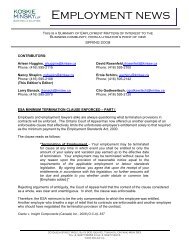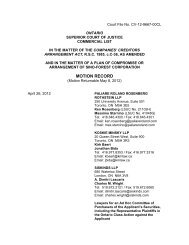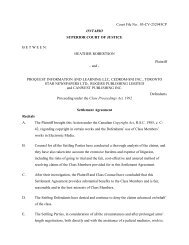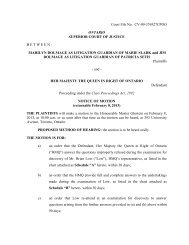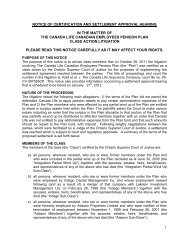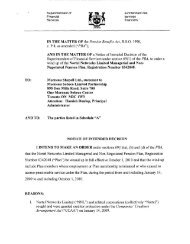Labour Injunctions & Cease and Desist Orders in Ontario
Labour Injunctions & Cease and Desist Orders in Ontario
Labour Injunctions & Cease and Desist Orders in Ontario
You also want an ePaper? Increase the reach of your titles
YUMPU automatically turns print PDFs into web optimized ePapers that Google loves.
[5]<br />
Section 102(3) then provides that <strong>in</strong> order for an <strong>in</strong>junction to be issued an employer must satisfy<br />
the court that:<br />
reasonable efforts to obta<strong>in</strong> police assistance, protection <strong>and</strong> action<br />
to prevent or remove any alleged danger of damage to property,<br />
<strong>in</strong>jury to persons, obstruction of or <strong>in</strong>terference with lawful entry<br />
or exit from the premises <strong>in</strong> question or breach of the peace have<br />
been unsuccessful.<br />
The court has considered the circumstances under which it will f<strong>in</strong>d that reasonable efforts to<br />
obta<strong>in</strong> police assistance have been unsuccessful with<strong>in</strong> the mean<strong>in</strong>g of section 102(3).<br />
Specifically, the courts considered the issue <strong>in</strong> Industrial Hardwood Products (1996) Ltd. v.<br />
International Wood & Allied Workers of Canada, Local 2693 12 (“Industrial Hardwood”) <strong>and</strong><br />
Cancoil Thermal Corp. v. Abbott 13 (“Cancoil”).<br />
Industrial Hardwood <strong>in</strong>volved an <strong>in</strong>junction issued under section 102(3) of the Courts of<br />
Justice Act <strong>in</strong> relation to a legal strike. Dur<strong>in</strong>g the course of the strike, the employer had hired<br />
replacement workers <strong>and</strong> used vans to transport them <strong>in</strong>to <strong>and</strong> out of the company premises. For<br />
approximately three months, picket<strong>in</strong>g employees obstructed the vans. However, the picketers<br />
would obey police orders <strong>and</strong> move when <strong>in</strong>structed to do so by the police. The employer<br />
obta<strong>in</strong>ed an <strong>in</strong>junction under section 102(3) that prohibited picketers from prevent<strong>in</strong>g or<br />
attempt<strong>in</strong>g to prevent vehicular access to the company’s premises. The <strong>in</strong>junction also prohibited<br />
all picket<strong>in</strong>g at the plant except picket<strong>in</strong>g for the purpose of communicat<strong>in</strong>g <strong>in</strong>formation to those<br />
wish<strong>in</strong>g to receive it. Such communications were limited to five m<strong>in</strong>utes <strong>in</strong> length under the<br />
terms of the <strong>in</strong>junction. F<strong>in</strong>ally, the <strong>in</strong>junction limited the number of picketers to four at each<br />
plant entrance. The union appealed the <strong>in</strong>junction order, argu<strong>in</strong>g that because the picketers<br />
12 Industrial Hardwood Products (1996) Ltd. v International Wood & Allied Workers of Canada, Local 2693 (2001),<br />
196 DLR (4th) 320, 52 OR (3d) 694 (Ont CA) [Industrial Hardwood].<br />
13 Cancoil Thermal Corp. v Abbott, [2004] OJ No 3016 (Ont Sup Ct) [Cancoil].






